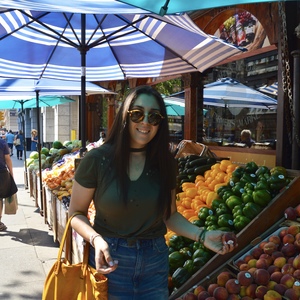Food trends excite me just as much as the next person, but I can’t be the only one who feels as though it’s time for society to take a much-needed break from the “unicorn food” trend. For those unfamiliar, unicorn food places an emphasis on rainbow food items representative of the colors found in unicorns (think Lisa Frank-esque).
According to an interview with Refinery29, trend expert Daniel Levine says society has always been slightly curious about the idea of unicorns, “in hopes that maybe a whimsical notion could be proven true.”
It’s purely understandable and innocent to feel this way, but the utilization of a unicorn as a basis for self-expression and creativity through food is unnatural and does not reflect the true flavors and colors of which food has to offer. A few unicorn lattes and Frappuccinos at first were fine, but when the trend began to trickle into other food groups such as cheese and sandwiches, it should have been stopped.
I’m not denying it one bit, unicorn food products are very aesthetically pleasing and nice to look at. Paired with some good photography skills, you could really have a stellar photo (and there are a lot of those), but this is predominately the only thing they’re useful for; a photography portrait and social media star. The unicorn food trend takes away from the natural taste and color vibrancy of food and is not exactly healthy.
The Color
Yes, the food is nice to look at, but maybe just a bit too nice and perfect. There’s currently much emphasis being put on the phrase, “eat the rainbow,” but it was never intended to be through different food dyes. “Eat the rainbow” means to include a variety of foods, mainly fruits and vegetables, which are naturally vibrant in color in your diet. I’d much rather prefer a rainbow veggie grilled cheese than a pastel food dye-filled grilled cheese. It’s way more appetizing and highlights the natural colors found in vegetables.
Visually, I don’t think that the hues present in unicorn food products are appealing to chefs or anyone who shares a true appreciation of genuine food dishes. People enjoy receiving a plate and being able to identify what is being eaten, at least to a certain extent.
The Taste
In today’s society, texture and presentation are important in the food world, but what it all comes down to at the end of the day is the taste. Let me just say, these unicorn food products and dishes do not always taste like magic.
Ranging from things like Starbucks Frappuccinos, bagels, cereal, smoothie bowls, toast, pastries—the trend has become contagious to food producers and restaurants internationally. Many companies and chefs have put their own unique twist on the unicorn food trend on their products and dishes through the presentation. The one thing all of these food items share is one similar feature though, and that’s an overpowering sugary taste.
When I go out to eat, I often seek a dish that sounds visually appealing so I can showcase it for Instagram. But the thing I mainly look for is what ingredients make up the flavor of the dish. The most common ingredients used in unicorn food products are sugar, dyes, powders, edible glitter, and frosting. There is nothing less appealing than eating food that tastes like straight sugar or glitter.
The Health Side of Things
I may sound a bit dramatic, but it’s genuinely so confusing to grow up in a generation that one minute is said to be fueled by health foods and “clean eating” and the next is obsessed with sugary junk food. In case you weren’t aware, loads of sugar and dye is not good for you. Sugar and food dyes can cause weight gain and lead to obesity.
It particularly upsets me that so many people advocate for organically made food and yet support a movement which puts emphasis on these dyes and unnatural ingredients in dishes. A balance and moderation in one’s diet is vital, but it simply does not feel natural to advocate for something that can contain 59+ grams of sugar (Starbucks grande Unicorn Frappuccino).
The World Health Organization (WHO) recommends no more than 25 grams of sugar daily. Sugar may satisfy the body at first, but really, it just leaves it craving for more.
Moving Forward
Unicorn food lovers, I’m sorry if I’m offending you. However, this is my proposal. If you can reinvent this movement, I will reconsider. Reinvent as in find ways to take the dyes and powders out of these mainstream foods, and replace them with the real rainbow (veggies and natural coloring). It is definitely not impossible; some people are already do it. There are so many ingredients which possess natural vibrancy in both taste and color, and therefore have many health benefits as well. Even if society can’t say goodbye to the unicorn food trend just yet, it is definitely time to say goodbye to the dyes and replace them with the foods in nature that have the real magic in them.


